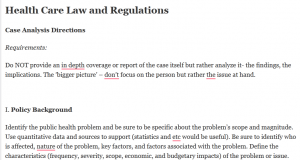Health Care Law and Regulations
Case Analysis Directions
Requirements:
Do NOT provide an in depth coverage or report of the case itself but rather analyze it- the findings, the implications. The ‘bigger picture’ – don’t focus on the person but rather the issue at hand.

I. Policy Background
Identify the public health problem and be sure to be specific about the problem’s scope and magnitude. Use quantitative data and sources to support (statistics and etc would be useful). Be sure to identify who is affected, nature of the problem, key factors, and factors associated with the problem. Define the characteristics (frequency, severity, scope, economic, and budgetary impacts) of the problem or issue. Below are some key questions that should help guide you in providing the necessary information.
Though I provide you with these questions your assignment should NOT be in question and answer format. It should be presented in paragraph format.
What is the problem to be addressed? State the problem meaningfully.
What was the event or series of event that was a catalyst for the case?
Is it a problem or crisis that demands immediate attention?
What interests are at stake for the actor (ie state or federal government) overall?
Use data to support
Focus on the central, critical factors
Identify who is concerned and why?
II. Facts of the Case
Include a summary of the pertinent facts and legal points raised in the case. It will show the nature of the litigation, based on what occurrences, and what happened in the lower court(s). Facts are often conveniently summarized at the beginning of the court’s published opinion. Sometimes, the best statement of the facts are found in a dissenting or concurring opinion. **Be careful though judges are not above being selective about the facts they emphasize. This can become of crucial important when you try to reconcile apparently inconsistent cases, because the way a judge chooses to characterize and ‘edit’ the facts often determines which way he or she will vote, as a result which rule of law will be applied.***
Keys: make sure you describe the nature of the case, a statement of the relevant law, a short summary of the case. Explain who did what to whom and why the case is being presented.
III. Reasoning and opinions
Identify the actions taken by the lower courts (if this case is being heard in the supreme court).If it was heard in the Supreme Court, identify how each justice voted. What was the decision? Was a policy created? A law upheld?
IV. Analysis
Evaluate the significance of the case, its relationship to other cases, its place in history, and what it shows about the Court, the impact it has on government, society, and public health implications. Go into depth here.
This section important- this is where the depth of the paper is. How does the case influence public health? Have any unintended consequences been identified
V. References
All references must be in APA format. There should be at least 3 references. Refrain from using the textbook. Use the textbook to assist you in identifying a case or where to look for information but do not cite the textbook. Quality sources- peer reviewed journal articles and other references. Governmental organizations count as quality references, stay away from blogs, opinion pieces and news articles. Should be written in Times New Roman font 12. Should be written in APA format and should be around 3-4 pages. References shouldn’t be older than 10 years unless discussing a historical component. Should be at least three references
Additional Information:
Topics
If you would like to use a case but are unsure if it fits the topic area, please feel free to send an email to cfreaney@monroecollege.edu with topic idea.
Websites that might help with your research:
(1) AMA- American Medical Association
https://www.ama-assn.org/amaone/ama-litigation-center-supreme-court-cases
(2) SCOTUS Blog- this can’t be used as a source, but it can be used a resource that will help you locate and identify cases.
https://www.scotusblog.com/category/special-features/special-features-archive/health-care/
(3) United States Courts
https://www.uscourts.gov/court-records/find-case-pacer
(4) Department of Justice https://www.justice.gov/
* An example is provided of a case just as an example for each topic area. You ae NOT required to use this case. Students are encouraged to find their own cases and explore court cases of interest to them in the designated topic area.
Case Analysis
Topic: Patient Rights and Responsibilities
Students may use any case as long as it is focused on the topic area of patients rights and responsibilities; death with dignity. Examples of this topic area are below but students are NOT required to use these cases, these are provided for students to get an idea of the topic area.
Case Examples:
(1) Rush Prudential H.M.O. v Moran, No. 00-1021
(2) Allen v. Harrison 2016 OK 44, Case Number: 111877https://law.justia.com/cases/oklahoma/supreme-court/2016/111877.html
(3) Ferguson v Charleston
Case Analysis 2
Topic: Reproductive Rights
Case Example: Whole Women’s Health v Cole
Students may use any case that is focused in the topic area of reproductive rights. This includes but is not limited to abortion, access/use/cost of birth control pills, embryos, and etc. If you would like to use a case but are unsure if it fits the topic area, please feel free to send an email to cfreaney@monroecollege.edu with topic idea.
Case Analysis 3 Student Choice
Topic: Students Choice Suggestions
Students may use any court case that is focused in healthcare or public health. This includes but is not limited to mandatory vaccination policies, right of organ donors/transplants, gun control, racism in healthcare, telemedicine, and etc. If you would like to use a case but are unsure if it fits the topic area, please feel free to send an email to cfreaney@monroecollege.edu with topic idea.